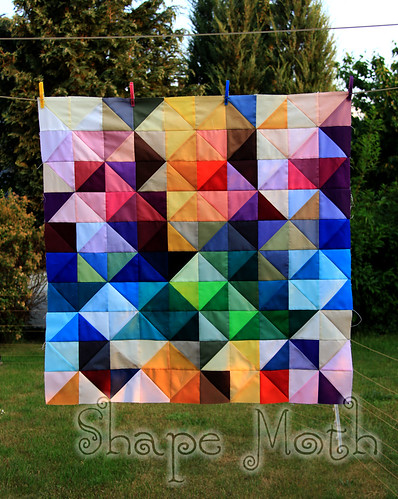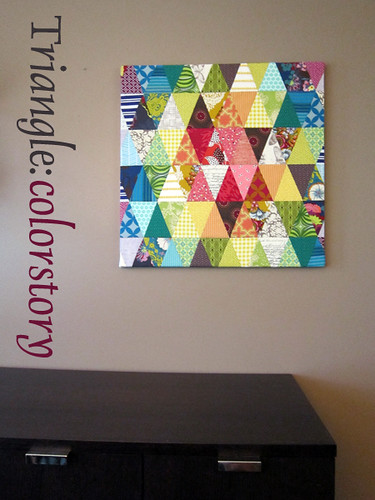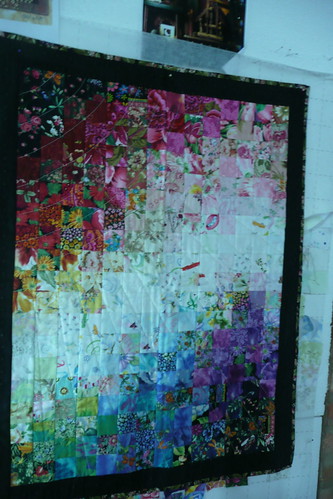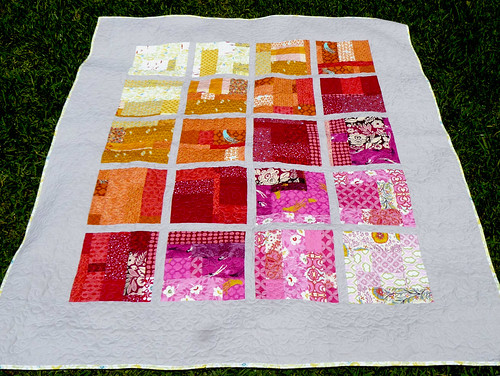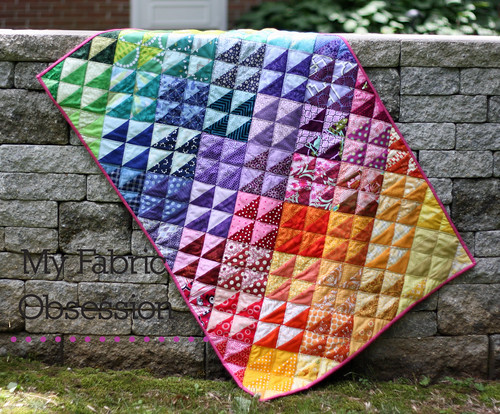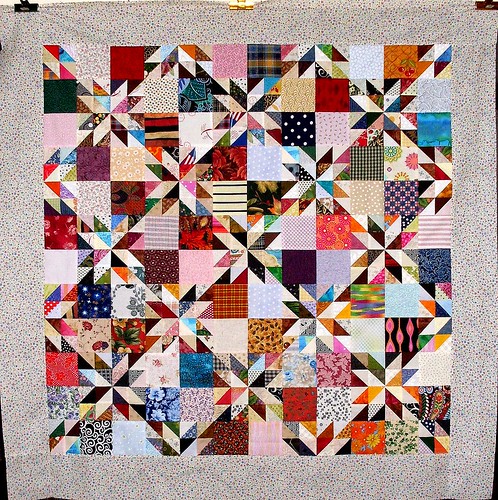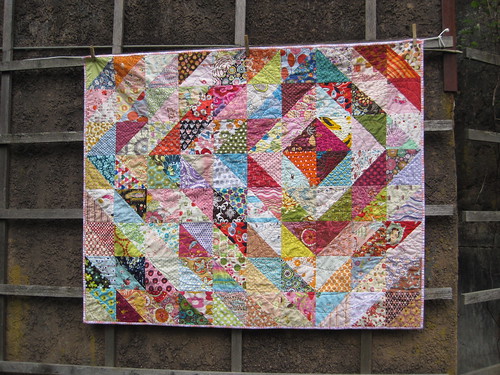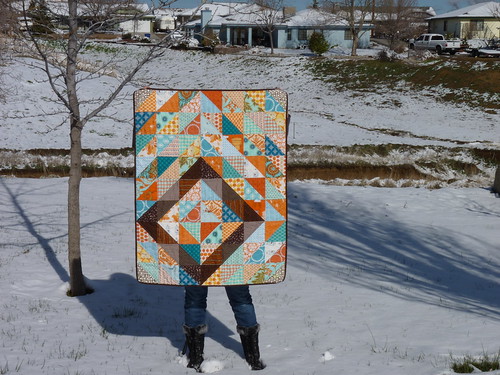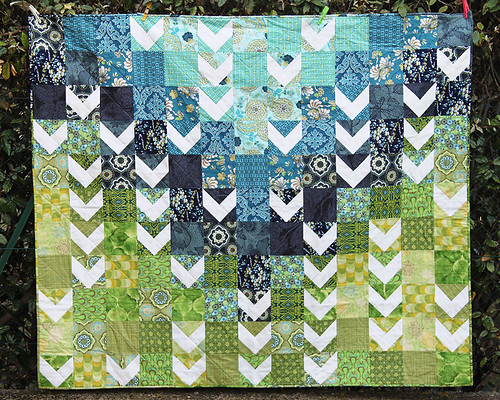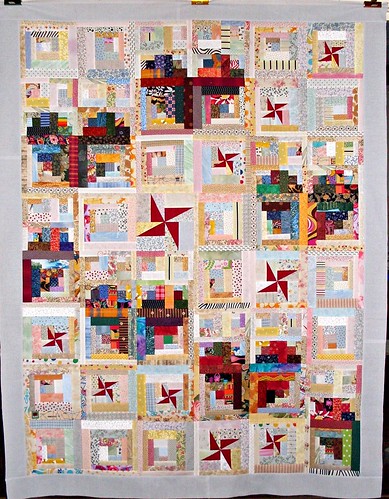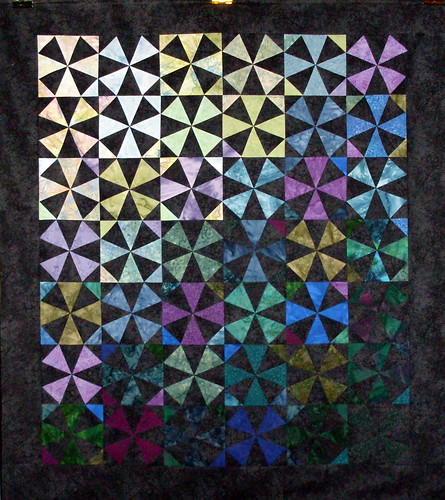Value Added {Value Patterns in Quilts}
Hello all! I bet you've been dreaming in lights and darks? I'm confident you understand value and Amy's helped us dive into our stash to pull it out. Now what will you make?
Well, before you start cutting, let's talk about some general categories of value quilts or value patterns you might consider. We quilt-along plotters discussed and identified 4 value patterns in quilts prior to settling on a value pattern theme. Much of what I'll share here was developed as a team, so thanks to Amy, Jolene and Leila for such a fruitful discussion.
Keep in mind that these value patterns have nothing to do with quilt construction. So, it doesn't matter if a quilt is composed of squares, half square triangles, triangles, strings, etc. The point is to notice how the light, medium and dark value fabrics are placed to create a fantastic design!
Scattered Value
Value does not have to be used in a regular, predictable way to be an important design element in a quilt. A scattered value pattern is when the lights and darks are not arranged in a repeating pattern. This glowing work-in-progress by ShapeMoth is a fabulous example:
Her Shattered Rainbow quilt has a strong, vibrant personality that lies in large part with her generous use of dark and light values, not just middle-of-the-road rainbow colors.
Here's another example of scattered value pattern, created by Krista at Spotted Stone Studio. The unpredictable placement of really dark values among so many light pieces keeps the eye moving so that the quilt seems to twinkle.
Although values appear to be placed randomly, in my experience this value pattern does take planning. You have to intentionally pull and cut fabrics of a wide range of value to achieve this effect. Also, when I work in scattered value, as with my Triangle Colorstory wall art, I don't actually place value totally randomly. I intentionally spread out the light and dark fabrics and then study the effect, shifting and repositioning until I'm pleased.
It seems to me that scattered value patterns are easily adopted by modern quilters. The lack of "pattern" itself feels modern and freeing, while the effect gives as much drama and movement as other approaches.
Radiating Value
This value pattern is another favorite of mine! Just as Amy showed us yesterday, when values are arranged light to dark in a continuum they naturally lead the eye, drawing focus to one section of quilt. When quilters set out fabrics in order of value, it creates a lovely glow where the light values live and an echoing deep, darkness at the darks.
This watercolor quilt by Silort is a beautiful example. Here light values radiate diagonally from the center of the quilt into two dark corners.
This one, by Jenn of all Trades, is radiating the opposite direction with lights at both corners. Notice that she uses a much more limited color scheme than our first example. Jenn uses very dark reds (red usually wants to be dark) for the center. Darker oranges and darker purple/pinks form the rows closest to red, with lighter oranges and pinks fading away to almost-white log cabins at the corners. Totally fabulous!
Rhythmic Value
Both scattered value and radiating value patterns are taken in when you view the quilt as a whole. In contrast, rhythmic value patterns often exist at the block level. Quilts that use rhythmic value use value in a predictable and repetitive way. Here's an example:
I know, I know, it's gooooorgeous. This beauty by Becky at My Fabric Obsession is composed of quarter square triangles and inspired by Rita of Red Pepper's Half Square Triangle Overload quilt. It's one of my favorite rhythmic value quilts, probably because it's so full of color. Becky used one light and one dark-ish fabric in the same color family to make each set of quarter square triangles. The dark-ish fabric is always placed to point to the bottom of the quilt, creating an orderly setting that reminds me of flashing gems.
With rhythmic value there's a distinct pattern repeat throughout the whole quilt. A repetitive use of value often (but not always) results in secondary patterns. In this scrappy quilt, Linda Rotz Miller (a value genius) used star blocks and simple 4-patch blocks. Her careful use of value creates the illusion of pinwheels in the stars and other secondary shapes where the stars touch the 4-patch blocks. It's a quilt that keeps your eye moving. Using scraps, rather than same-fabrics or same-colors, makes the value relationships more subtle and possibly more interesting.
Have you seen this type of value quilt? It's made with half square triangles, each with one light and one dark side, arranged like a bulls-eye. These pretty quilts are quite popular and a great way to use scraps. Katie at Sew Katie Did (who made our example) put on a quilt-along 3 years ago for value quilts, including a tutorial for this style quilt. I include it among the rhythmic value pattern examples because the use of value is repetitive and predictable.
Any, yes any, quilt block can be made into a rhythmic value pattern if you approach quilt planning in terms of value (light vs. dark) rather than color. I often think in terms of color, so this type of designing is a definite stretch. It's a good exercise for sure!
Illustrative Value
One last type. Phew, are you exhausted? This one is kind of a catch-all. What do you call a quilt that uses value to say something, do something, make something, but not in a repetitive, radiating or scattered kind of way? Well, you could call it an illustrative values quilt. Haha. Or not.
Check out this example by Jen at MJandCo. It's not a bulls-eye spiral, like Katie's. Instead it's one single dark value square, just in the corner and then no more. Jen used value to "draw" a square. I think we'd all agree it looks very cool.
And then there's Flocking Chevrons by You Had Me at Bonjour. Although there's a pretty cascade of color happening in the background, what draws the eye are the white (light value) chevrons which pop out from the darker values. It's not just a scattered value quilt, because she's "drawn" chevrons in value.
Woa, did you know you could do that? It's Linda Rotz Miller at it again. I don't think you need me to point out that she's used value to illustrate hearts? These are each examples of illustrative value patterns.
So, pretty much, you can do anything (everything?) with value. How's that for some options?
Wait, there's more!
Because humans are infinitely creative, we can merge many of these patterns to the point that words fail to define. But if you like to classify, you might find some peachy crossbreed examples....
What do you see in this quilt also by Linda Rotz Miller? I see ryhthmic value, because each kaleidoscope block uses contrasting values in an alternating fashion. But, I also see radiating value with the light coming from the left upper corner.
Ooooh.
Well, I'd better stop while our heads are spinning but still firmly attached. If you thought you knew what you wanted to make at the beginning of this post and now you have four hundred ideas, I'm sorry (kind of). To narrow down the possibilities, the four of us agreed to make quilts with rhythmic value patterns. That's the style that's probably least used in modern quilting. Each of the quilts we'll be teaching, have a repetitive value element ( see them again here). But, remember, you can make one of ours or make your own to join in with the quilt-along and November 30th link party. The world is your oyster!
Tomorrow Jolene has more to share on value in quilting. See you at Blue Elephant Stitches!
Psst... if I don't see you sooner at the Value Added flickr group.
Well, before you start cutting, let's talk about some general categories of value quilts or value patterns you might consider. We quilt-along plotters discussed and identified 4 value patterns in quilts prior to settling on a value pattern theme. Much of what I'll share here was developed as a team, so thanks to Amy, Jolene and Leila for such a fruitful discussion.
Keep in mind that these value patterns have nothing to do with quilt construction. So, it doesn't matter if a quilt is composed of squares, half square triangles, triangles, strings, etc. The point is to notice how the light, medium and dark value fabrics are placed to create a fantastic design!
Scattered Value
Value does not have to be used in a regular, predictable way to be an important design element in a quilt. A scattered value pattern is when the lights and darks are not arranged in a repeating pattern. This glowing work-in-progress by ShapeMoth is a fabulous example:
Her Shattered Rainbow quilt has a strong, vibrant personality that lies in large part with her generous use of dark and light values, not just middle-of-the-road rainbow colors.
Here's another example of scattered value pattern, created by Krista at Spotted Stone Studio. The unpredictable placement of really dark values among so many light pieces keeps the eye moving so that the quilt seems to twinkle.
Although values appear to be placed randomly, in my experience this value pattern does take planning. You have to intentionally pull and cut fabrics of a wide range of value to achieve this effect. Also, when I work in scattered value, as with my Triangle Colorstory wall art, I don't actually place value totally randomly. I intentionally spread out the light and dark fabrics and then study the effect, shifting and repositioning until I'm pleased.
It seems to me that scattered value patterns are easily adopted by modern quilters. The lack of "pattern" itself feels modern and freeing, while the effect gives as much drama and movement as other approaches.
Radiating Value
This value pattern is another favorite of mine! Just as Amy showed us yesterday, when values are arranged light to dark in a continuum they naturally lead the eye, drawing focus to one section of quilt. When quilters set out fabrics in order of value, it creates a lovely glow where the light values live and an echoing deep, darkness at the darks.
This watercolor quilt by Silort is a beautiful example. Here light values radiate diagonally from the center of the quilt into two dark corners.
This one, by Jenn of all Trades, is radiating the opposite direction with lights at both corners. Notice that she uses a much more limited color scheme than our first example. Jenn uses very dark reds (red usually wants to be dark) for the center. Darker oranges and darker purple/pinks form the rows closest to red, with lighter oranges and pinks fading away to almost-white log cabins at the corners. Totally fabulous!
Rhythmic Value
Both scattered value and radiating value patterns are taken in when you view the quilt as a whole. In contrast, rhythmic value patterns often exist at the block level. Quilts that use rhythmic value use value in a predictable and repetitive way. Here's an example:
I know, I know, it's gooooorgeous. This beauty by Becky at My Fabric Obsession is composed of quarter square triangles and inspired by Rita of Red Pepper's Half Square Triangle Overload quilt. It's one of my favorite rhythmic value quilts, probably because it's so full of color. Becky used one light and one dark-ish fabric in the same color family to make each set of quarter square triangles. The dark-ish fabric is always placed to point to the bottom of the quilt, creating an orderly setting that reminds me of flashing gems.
With rhythmic value there's a distinct pattern repeat throughout the whole quilt. A repetitive use of value often (but not always) results in secondary patterns. In this scrappy quilt, Linda Rotz Miller (a value genius) used star blocks and simple 4-patch blocks. Her careful use of value creates the illusion of pinwheels in the stars and other secondary shapes where the stars touch the 4-patch blocks. It's a quilt that keeps your eye moving. Using scraps, rather than same-fabrics or same-colors, makes the value relationships more subtle and possibly more interesting.
Have you seen this type of value quilt? It's made with half square triangles, each with one light and one dark side, arranged like a bulls-eye. These pretty quilts are quite popular and a great way to use scraps. Katie at Sew Katie Did (who made our example) put on a quilt-along 3 years ago for value quilts, including a tutorial for this style quilt. I include it among the rhythmic value pattern examples because the use of value is repetitive and predictable.
Any, yes any, quilt block can be made into a rhythmic value pattern if you approach quilt planning in terms of value (light vs. dark) rather than color. I often think in terms of color, so this type of designing is a definite stretch. It's a good exercise for sure!
Illustrative Value
One last type. Phew, are you exhausted? This one is kind of a catch-all. What do you call a quilt that uses value to say something, do something, make something, but not in a repetitive, radiating or scattered kind of way? Well, you could call it an illustrative values quilt. Haha. Or not.
Check out this example by Jen at MJandCo. It's not a bulls-eye spiral, like Katie's. Instead it's one single dark value square, just in the corner and then no more. Jen used value to "draw" a square. I think we'd all agree it looks very cool.
And then there's Flocking Chevrons by You Had Me at Bonjour. Although there's a pretty cascade of color happening in the background, what draws the eye are the white (light value) chevrons which pop out from the darker values. It's not just a scattered value quilt, because she's "drawn" chevrons in value.
Woa, did you know you could do that? It's Linda Rotz Miller at it again. I don't think you need me to point out that she's used value to illustrate hearts? These are each examples of illustrative value patterns.
So, pretty much, you can do anything (everything?) with value. How's that for some options?
Wait, there's more!
Because humans are infinitely creative, we can merge many of these patterns to the point that words fail to define. But if you like to classify, you might find some peachy crossbreed examples....
What do you see in this quilt also by Linda Rotz Miller? I see ryhthmic value, because each kaleidoscope block uses contrasting values in an alternating fashion. But, I also see radiating value with the light coming from the left upper corner.
Ooooh.
Well, I'd better stop while our heads are spinning but still firmly attached. If you thought you knew what you wanted to make at the beginning of this post and now you have four hundred ideas, I'm sorry (kind of). To narrow down the possibilities, the four of us agreed to make quilts with rhythmic value patterns. That's the style that's probably least used in modern quilting. Each of the quilts we'll be teaching, have a repetitive value element ( see them again here). But, remember, you can make one of ours or make your own to join in with the quilt-along and November 30th link party. The world is your oyster!
Tomorrow Jolene has more to share on value in quilting. See you at Blue Elephant Stitches!
Psst... if I don't see you sooner at the Value Added flickr group.

